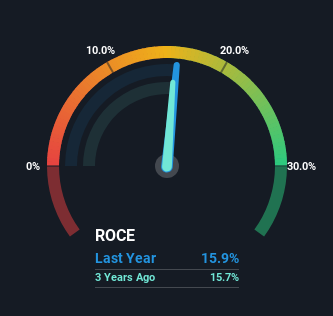The Returns At Oxford Instruments (LON:OXIG) Aren't Growing
Did you know there are some financial metrics that can provide clues of a potential multi-bagger? Firstly, we'd want to identify a growing return on capital employed (ROCE) and then alongside that, an ever-increasing base of capital employed. This shows us that it's a compounding machine, able to continually reinvest its earnings back into the business and generate higher returns. So, when we ran our eye over Oxford Instruments' (LON:OXIG) trend of ROCE, we liked what we saw.
What Is Return On Capital Employed (ROCE)?
For those that aren't sure what ROCE is, it measures the amount of pre-tax profits a company can generate from the capital employed in its business. Analysts use this formula to calculate it for Oxford Instruments:
Return on Capital Employed = Earnings Before Interest and Tax (EBIT) ÷ (Total Assets - Current Liabilities)
0.16 = UK£62m ÷ (UK£576m - UK£190m) (Based on the trailing twelve months to September 2023).
Thus, Oxford Instruments has an ROCE of 16%. On its own, that's a standard return, however it's much better than the 13% generated by the Electronic industry.
See our latest analysis for Oxford Instruments
In the above chart we have measured Oxford Instruments' prior ROCE against its prior performance, but the future is arguably more important. If you'd like, you can check out the forecasts from the analysts covering Oxford Instruments for free.
What Can We Tell From Oxford Instruments' ROCE Trend?
While the current returns on capital are decent, they haven't changed much. The company has consistently earned 16% for the last five years, and the capital employed within the business has risen 67% in that time. Since 16% is a moderate ROCE though, it's good to see a business can continue to reinvest at these decent rates of return. Over long periods of time, returns like these might not be too exciting, but with consistency they can pay off in terms of share price returns.
What We Can Learn From Oxford Instruments' ROCE
In the end, Oxford Instruments has proven its ability to adequately reinvest capital at good rates of return. And the stock has done incredibly well with a 126% return over the last five years, so long term investors are no doubt ecstatic with that result. So while investors seem to be recognizing these promising trends, we still believe the stock deserves further research.
Oxford Instruments does have some risks though, and we've spotted 1 warning sign for Oxford Instruments that you might be interested in.
While Oxford Instruments isn't earning the highest return, check out this free list of companies that are earning high returns on equity with solid balance sheets.
Have feedback on this article? Concerned about the content? Get in touch with us directly. Alternatively, email editorial-team (at) simplywallst.com.
This article by Simply Wall St is general in nature. We provide commentary based on historical data and analyst forecasts only using an unbiased methodology and our articles are not intended to be financial advice. It does not constitute a recommendation to buy or sell any stock, and does not take account of your objectives, or your financial situation. We aim to bring you long-term focused analysis driven by fundamental data. Note that our analysis may not factor in the latest price-sensitive company announcements or qualitative material. Simply Wall St has no position in any stocks mentioned.

